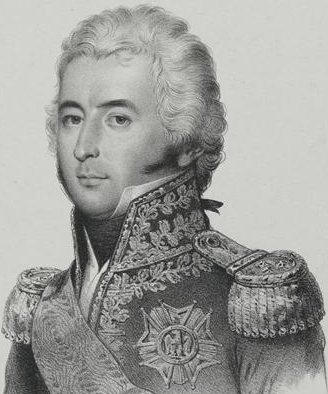Nansouty’s cuirassiers charging at the Battle of Friedland on 14 June 1807.
Nansouty was one of Napoleon’s foremost heavy cavalry leaders. He served in most of the Emperor’s battles and earned respect for his deliberate and devastating charges. Although Nansouty was considered by many to be overly cautious, he was a commander who prided himself on taking care of his men.
Nansouty was born in Bordeaux on 30 May 1768 into a noble family. He was sent to the military academy at Brienne in 1782, along with other members of the nobility. He graduated in 1785 and was commissioned as a second lieutenant in the Burgundy cavalry regiment. Despite Nansouty’s aristocratic background, the French Revolution opened many opportunities for him. While many other nobles fled the country or were executed, Nansouty advanced rapidly in rank in the expanding French Army. In 1792 he became lieutenant colonel of the 2nd Chasseurs a Cheval. Over the next decade, Nansouty served in the Army of the Rhine. In 1799 he was promoted to général de brigade and saw action at Stockach and Memmingen.
Nansouty’s career advanced rapidly under Napoleon’s rule. In March 1803 he became général de division. That year he served under General Adolphe Mortier in the conquest of Hanover. Nansouty then became part of the army at the camp of Boulogne, awaiting the right conditions for an invasion of England. In August 1805 he took command of the newly formed 1st Cuirassier Division, part of Marshal Joachim Murat’s cavalry corps. Nansouty’s division was an integral part of the striking power of the Grande Armée. During the 1805 campaign Nansouty was present at the battles of Wertingen, Ulm, and Austerlitz, and he gained the reputation of being a cautious commander, even to the point of being slow. In part, the care with which Nansouty deployed his troops was a result of his fatherly attitude toward them. He also regarded Murat as headstrong and overly zealous, viewing himself as a counterbalance.
During 1806 Nansouty fought in the campaign in East Prussia and Poland. His cuirassiers played important roles in the Battle of Golymin in late 1806 and at Eylau and Friedland in 1807. Napoleon noted Nansouty’s performance, and in 1808 he named the cavalry commander as his First Equerry, as well as Count of the Empire. Nansouty accompanied Napoleon during his 1808 campaign in Spain and then back to Paris to prepare for war against the Austrians. In 1809 Nansouty headed the 1st Cuirassier Division under Marshal Jean-Baptiste Bessieres and participated in the battles along the Danube, including Aspern- Essling and Wagram.
During the invasion of Russia in 1812, Nansouty commanded I Cavalry Corps in the Cavalry Reserve. He fought in the battles of Ostrovno and Borodino. He was wounded in the latter battle and missed the remainder of the campaign, in the course of which the cavalry was decimated by the sufferings of the retreat. The replacements that Nansouty trained and commanded during the 1813 campaign in Germany were inferior in many ways. He commanded the cavalry of the Imperial Guard in fighting at Dresden, Leipzig, and Hanau, at the last of which he was again wounded. Nansouty recovered to fight in the 1814 campaign in France.
Despite the rewards Nansouty received from Napoleon, including being named First Chamberlain to Empress Josephine, he was no Bonapartist and quickly swore allegiance to Louis XVIII upon Napoleon’s exile to Elba. He was named aide to the comte d’Artois and captain lieutenant of the Mousquetaires Gris (Gray Musketeers). Nansouty died in Paris on 12 February 1815, before Napoleon’s return from Elba.
References and further reading Johnson, David. 1978. Napoleon’s Cavalry and Its Leaders. New York: Holmes and Meier. Ryan, Edward, and Lucien Rousselot. 1999. Napoleon’s Elite Cavalry: Cavalry of the Imperial Guard, 1804-1815. Mechanicsburg, PA: Stackpole.
